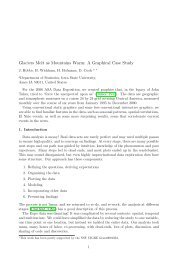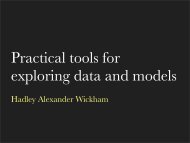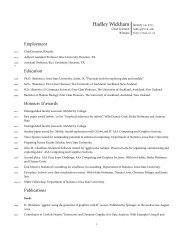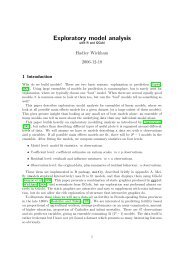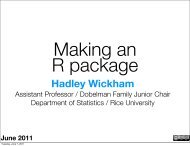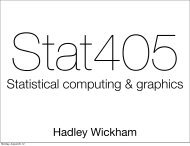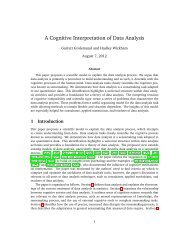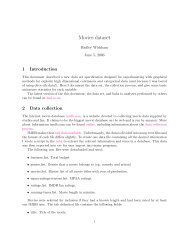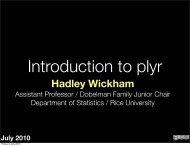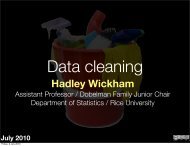Statistical inference for exploratory data analysis ... - Hadley Wickham
Statistical inference for exploratory data analysis ... - Hadley Wickham
Statistical inference for exploratory data analysis ... - Hadley Wickham
You also want an ePaper? Increase the reach of your titles
YUMPU automatically turns print PDFs into web optimized ePapers that Google loves.
4368 A. Buja et al.<br />
Of these approaches, the first is the least general but when it applies it yields an<br />
exact theory. It does apply to the examples used in this paper: null hypotheses of<br />
independence in EDA, and of normal linear models in MD. The resulting reference<br />
distributions are, respectively:<br />
EDA: permutation distributions, whereby the observed values are subjected to<br />
random permutations within variables or blocks of variables; and<br />
MD: ‘residual rotation distributions’, whereby random vectors are sampled in<br />
residual space with length to match the observed residual vector.<br />
Of the two, the <strong>for</strong>mer are well known from the theory of permutation tests,<br />
but the latter are lesser known and were apparently explicitly introduced only<br />
recently in a theory of ‘rotation tests’ by Langsrud (2005). When H0 consists<br />
of a more complex model where reduction with a minimal sufficient statistic is<br />
unavailable, parametric bootstrap sampling or posterior predictive sampling will<br />
generally be available. More details on these topics can be found in the electronic<br />
supplementary material. We next discuss two protocols <strong>for</strong> the inferential use of<br />
null plots based on null <strong>data</strong>sets drawn from reference distributions according to<br />
any of the above principles.<br />
4. Protocol 1: ‘the Rorschach’<br />
We call the first protocol ‘the Rorschach’, after the test that has subjects interpret<br />
inkblots, because the purpose is to measure a <strong>data</strong> analyst’s tendency to overinterpret<br />
plots in which there is no or only spurious structure. The measure is<br />
the family-wise Type I error rate of discovery, and the method is to expose the<br />
‘discovery black box’, meaning the <strong>data</strong> analyst, to a number of null plots and<br />
tabulate the proportion of discoveries which are by construction spurious. It yields<br />
results that are specific to the particular <strong>data</strong> analyst and context of <strong>data</strong> <strong>analysis</strong>.<br />
Different <strong>data</strong> analysts would be expected to have different rates of discovery, even<br />
in the same <strong>data</strong> <strong>analysis</strong> situation. The protocol will bring a level of objectivity<br />
to the subjective and cultural factors that influence individual per<strong>for</strong>mance.<br />
The Rorschach lends itself to cognitive experimentation. While reminiscent of<br />
the controversial Rorschach inkblot test, the goal would not be to probe individual<br />
analysts’ subconscious, but to learn about factors that affect their tendency to<br />
see structure when in fact there is none. This protocol estimates the effective<br />
family-wise Type I error rate but does not control it at a desired level.<br />
Producing a rigorous protocol requires a division of labour between a protocol<br />
administrator and the <strong>data</strong> analyst, whereby the administrator (i) generates the<br />
null plots to which the <strong>data</strong> analyst is exposed and (ii) decides what contextual<br />
prior in<strong>for</strong>mation the <strong>data</strong> analyst is permitted to have. In particular, the <strong>data</strong><br />
analyst should be left in uncertainty as to whether or not the plot of the real <strong>data</strong><br />
will appear among the null plots; otherwise, knowing that all plots are null plots,<br />
the <strong>data</strong> analyst’s mind would be biased and prone to complacency. Neither the<br />
administrator nor the <strong>data</strong> analyst should have seen the plot of the real <strong>data</strong><br />
so as not to bias the process by leaking in<strong>for</strong>mation that can only be gleaned<br />
from the <strong>data</strong>. To ensure protective ignorance of all parties, the administrator<br />
might programme the series of null plots in such a way that the plot of the real<br />
<strong>data</strong> is inserted with known probability in a random location. In this manner, the<br />
Phil. Trans. R. Soc. A (2009)<br />
Downloaded from<br />
rsta.royalsocietypublishing.org on January 7, 2010



